Illegal pot trade linked to Mexican drug cartels leaves contaminants, dead animals behind
TRINITY COUNTY, Calif. ― Standing atop a ridge in Shasta-Trinity National Forest, Mourad Gabriel watches as the last of the morning’s fog burns off, revealing the snow-capped Trinity Alps in the distance and a rolling sea of evergreens below.
In this slice of rural California, about five hours north of San Francisco, narrow two-lane roads snake between towering mountains and ancient trees. Millions of acres, bursting with biodiversity, are preserved as public lands by the U.S. Forest Service and Bureau of Land Management.
Between the lines of this postcard-worthy scene, Gabriel, a wildlife biologist and researcher for the Forest Service, studies a grim threat.
In the mountainous expanse below, drug trafficking organizations have taken advantage of Northern California’s remote wilderness to grow cannabis in deep defiance of the state’s marijuana and environmental regulations.
They’ve poisoned soil, streams and wildlife with banned pesticides, leveled countless acres of forest, ignited massive wildfires, poached billions of gallons of precious water and left nothing but death and debris in their wake.
Cannabis has been the lifeblood of Northern California’s economy for decades. And the state’s regulatory process for legal cannabis cultivation, still in its relative infancy, is burdensome and often prohibitive to the very industry the communities here were built around.
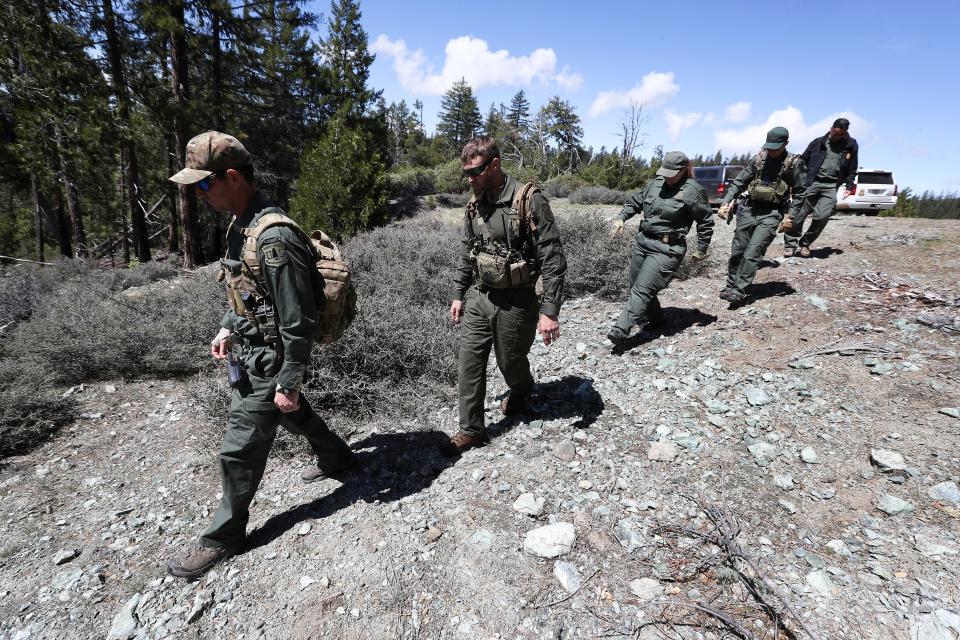
But unlike the region’s local industry, the drug trafficking organizations operating illegal cannabis grow sites in national forests and public lands, often called “trespass grows,” have proven merciless in their disregard for natural resources.
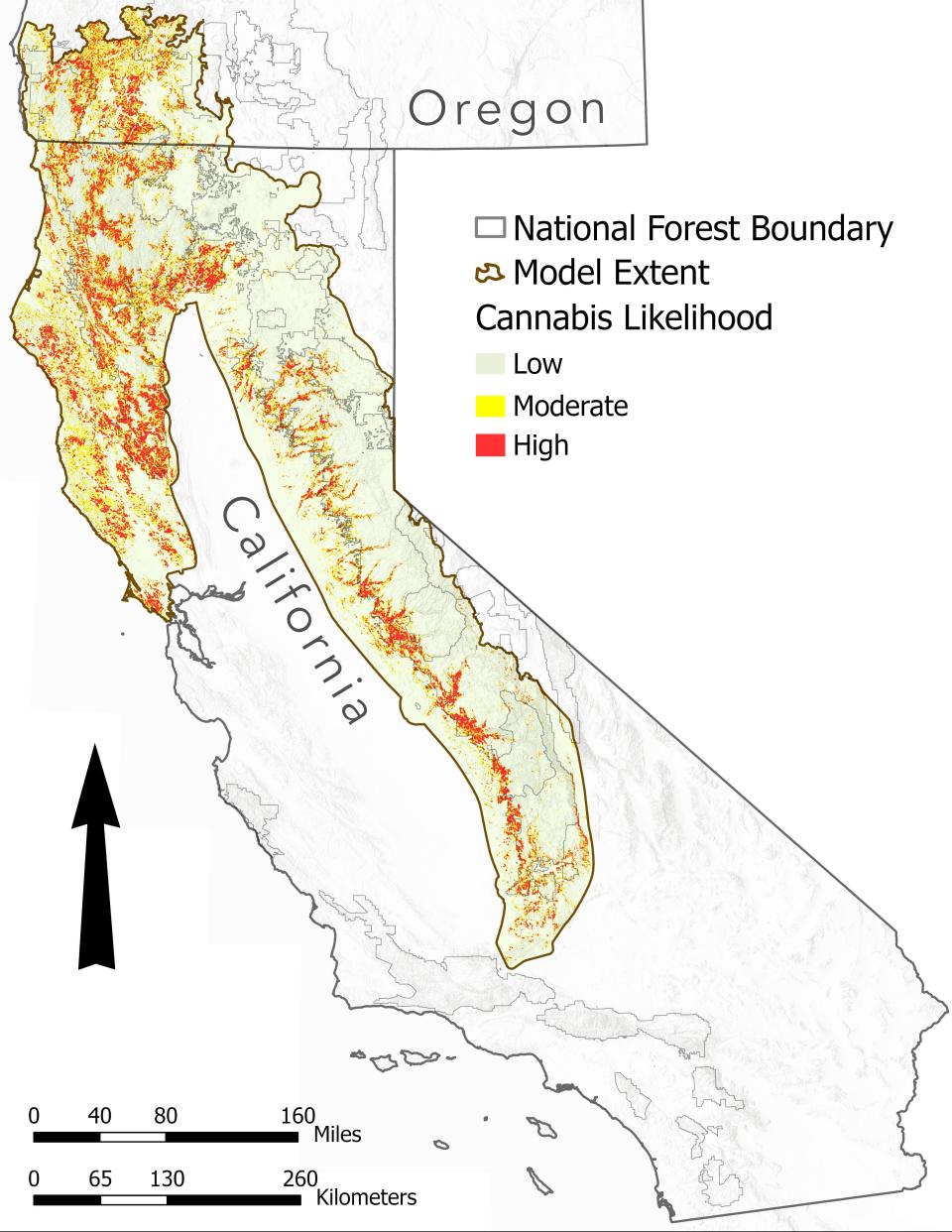
There are at least 5,800 trespass grow sites littering U.S. public lands, based on very conservative estimates, Gabriel said.
A vast majority were established by drug trafficking organizations, some connected to Mexican cartels and other international crime syndicates, based on law enforcement findings of graffiti, tattoos and other evidence tying suspects to certain organizations.
More than half are in California, with large concentrations in the state’s northern forests and up into Oregon. The tree canopy helps hide drug trafficking operations from the authorities, who often use aerial surveillance to identify trespass grows.
And in these mountains, stretching from the Sierras to the sea, law enforcement presence is as scarce as a cell signal. Sheriff’s departments are stretched thin across rural counties that take several hours to traverse end-to-end.
More on cannabis: 'Trying to make ends meet': Oregon secretary of state Shemia Fagan resigns amid cannabis scandal
Government officials, researchers and coalitions focused on the issue say the prevalence of illegal cannabis cultivation on public lands has declined in recent years, as enforcement efforts have coalesced, illicit growers have moved onto private property and marijuana prices have fallen.
But highly toxic pesticides used on trespass grows have made their way into the finished marijuana, which may be shipped anywhere in the country through black market channels. Large quantities of several banned chemicals were detected in cannabis products being sold at unlicensed dispensaries in the Los Angeles, one KCET investigation found.
And long after drug traffickers have moved on or been removed from a trespass grow, the environmental devastation to wildlife and natural resources remains.
Poisoning an entire food chain
Parked in a dirt turnout, Mark Higley climbs out of a mud-streaked pickup truck and grabs four live mice out of the bed.
He puts the mice in a compartment on his pack, grabs a trekking pole and hard hat, and walks down the road to a lookout. Below him, a steep dropoff rolls into the forestland of the Hoopa Valley Tribe reservation.
Higley, a soft-spoken wildlife biologist for Hoopa Valley Tribal Forestry, has been studying the northern spotted owls on this land for over 30 years. The owls here know him well.
He begins to call out, and a female approaches cautiously, gliding from branch to branch. He feeds her a mouse or two, then sets out to follow the owl home, hoping to confirm her nest and note which tree she’s chosen.
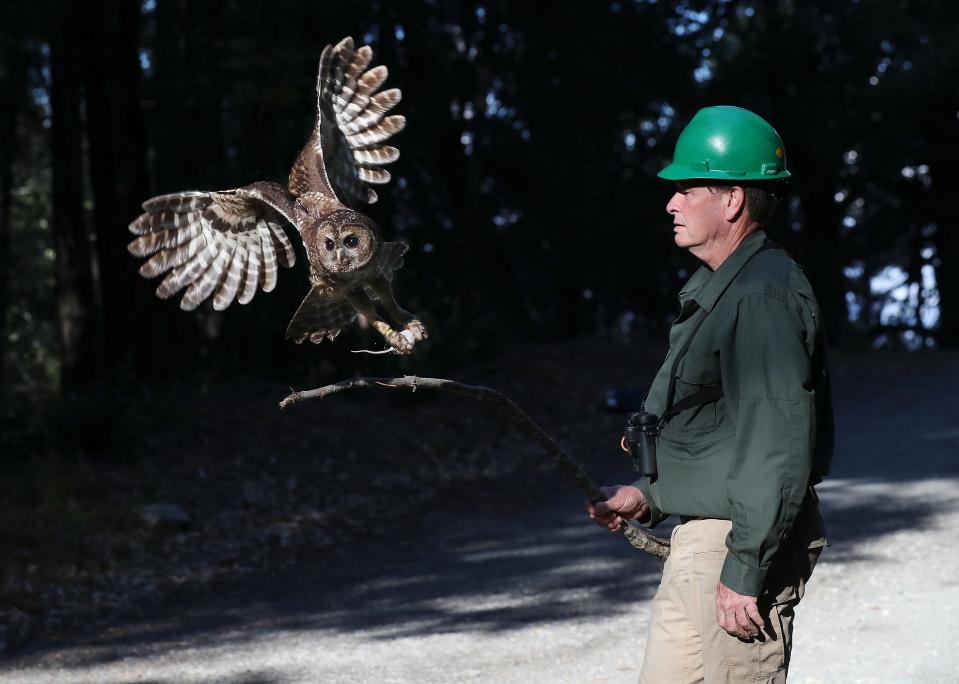

The northern spotted owl is a threatened species and is eligible for an endangered listing. It’s at risk of extinction from the more dominant barred owl, which has muscled into the northern spotted owl’s territory, and a scourge of western wildfires that have scorched much of what’s left.
But there’s another threat: pesticides.
The anticoagulant rodenticides used on illegal cannabis grows in California’s forests are designed to kill just about any living thing they come into contact with, but the dusky-footed woodrat is especially in the crosshairs.
The woodrat is a key food source for the northern spotted owl.
Law enforcement officials and researchers have consistently found containers of pesticides like carbofuran, a restricted-use neurotoxic chemical, near trespass grows. The bottles often have Spanish-language labels, likely indicating they were brought north from Mexico for use in California’s forests.
When they’re applied to public lands, they can imperil food chains and multiple generations of wildlife. A female owl may eat a contaminated woodrat, become contaminated herself, then pass contamination onto her young through her ovaries.
“If you do a blood sample from mountain lions across the state, they’re eating animals that have come in contact with these poisons,” said Jackee Riccio, a wildlife biologist and regional field director for the Cannabis Removal On Public Lands Project. “To see that … in the top predator means that there is rampant bioaccumulation throughout all other ecosystems. So, that’s a really big deal.”

On a trespass grow investigation 10 years ago, Higley came across a Pacific fisher in its final moments, “still foaming at the mouth.” Trespass growers had left poisoned hot dogs around the perimeter of a cultivation site, which the carnivorous fisher then ate, based on findings in its system.
Elusive members of the weasel family, fishers are native to parts of the North American west and endangered in the lower Sierras. The Center for Biological Diversity sued the U.S. Fish and Wildlife Service in September for denying the fisher endangered status in its northern range.
A study from 2021 found significant overlap between areas with likely concentrations of trespass grows and habitat for both fishers and the northern spotted owl.
Even after a grow site has been busted and cleared out, pesticides have been found in the soil up to five years later.
A decent rainfall, of which Northern California has had plenty this year, can wash pesticides into nearby waterways. The chemicals have already been detected in streams near trespass grows, and effects on aquatic species, like Northern California’s vital salmon species, are still largely unknown.
Pesticides have also been found in game species like deer, placing humans at risk through meat consumption, and law enforcement officers have been hospitalized after coming into contact with chemicals on grow sites.
Drug traffickers’ cruelty to wildlife has not been limited to their choice of chemicals. One raid in Humboldt County found a flying squirrel nailed up to a wall by its wing flaps, and “appeared to have been poisoned,” according to the sheriff’s office.
Evidence of poaching has turned up on raids across the region, and animal skulls kept as trophies are a common find on trespass grow sites. Photos, shared with The Courier Journal by the Arcata-based Integral Ecology Research Center and others, depict dead bears, birds and other wildlife.
"In the beginning, I was just amazed by the creative ways that these growers would find to kill every animal that came close to their grow," said Greta Wengert, executive director of IERC and a longtime researcher on the impacts of trespass grows. "That was pretty shocking to me."
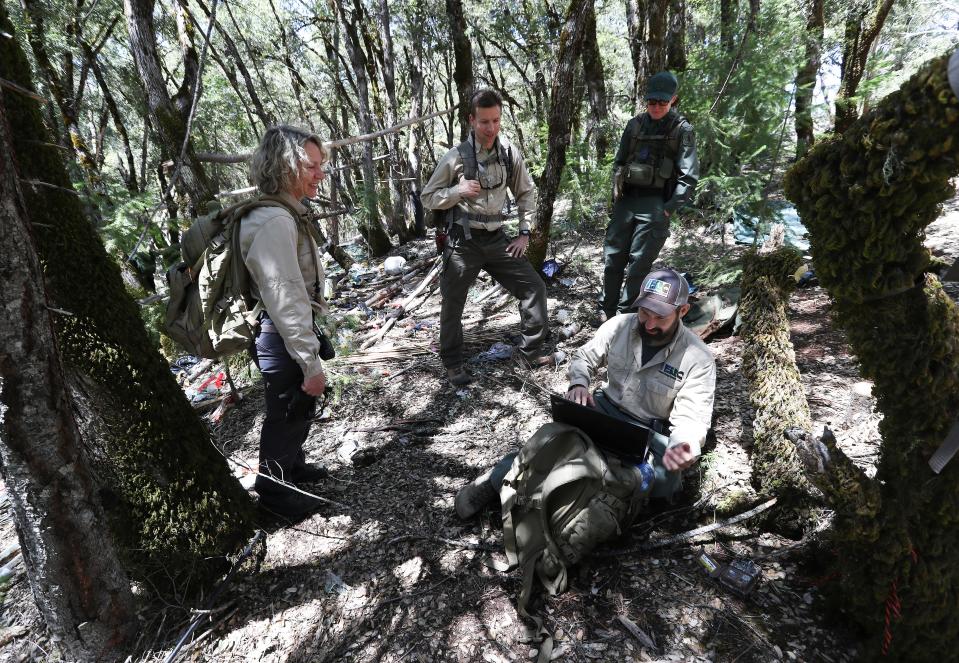
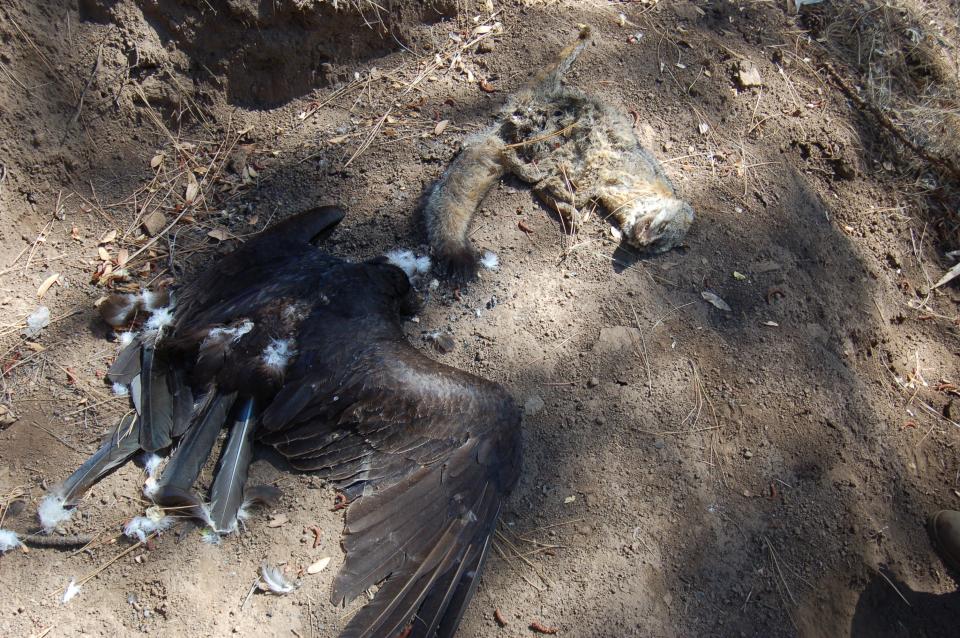
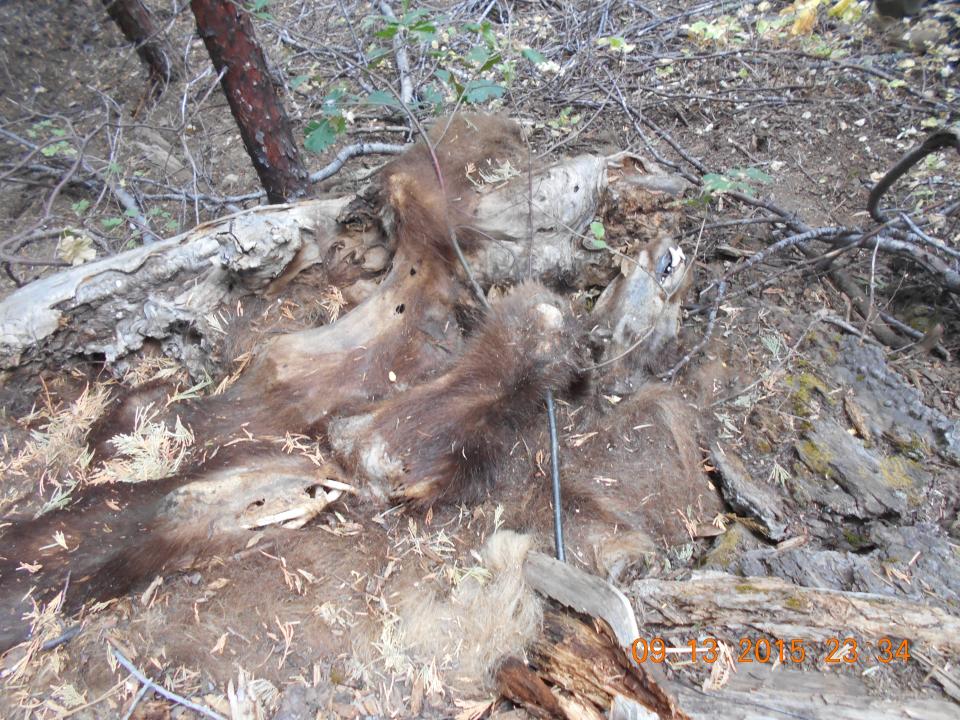
‘Looking down the business end of an AK-47’
While researchers with IERC and the Forest Service work to quantify the exact toll trespass grows have had on wildlife, the cost to cultural resources is immeasurable.
“This is our home,” said Vikki Preston, a cultural resources technician for the Karuk Tribe Department of Natural Resources. She lamented the impacts of trespass grows on Karuk ancestral lands and areas of cultural significance to her tribe.
Riccio, with the CROP Project, said the organization has prioritized working with local tribes like Preston’s to remediate grow sites after they’ve been cleared by law enforcement, including removing the remaining trash and infrastructure.
Preston said even the tribe’s inclusion in the work is a step forward from the past.
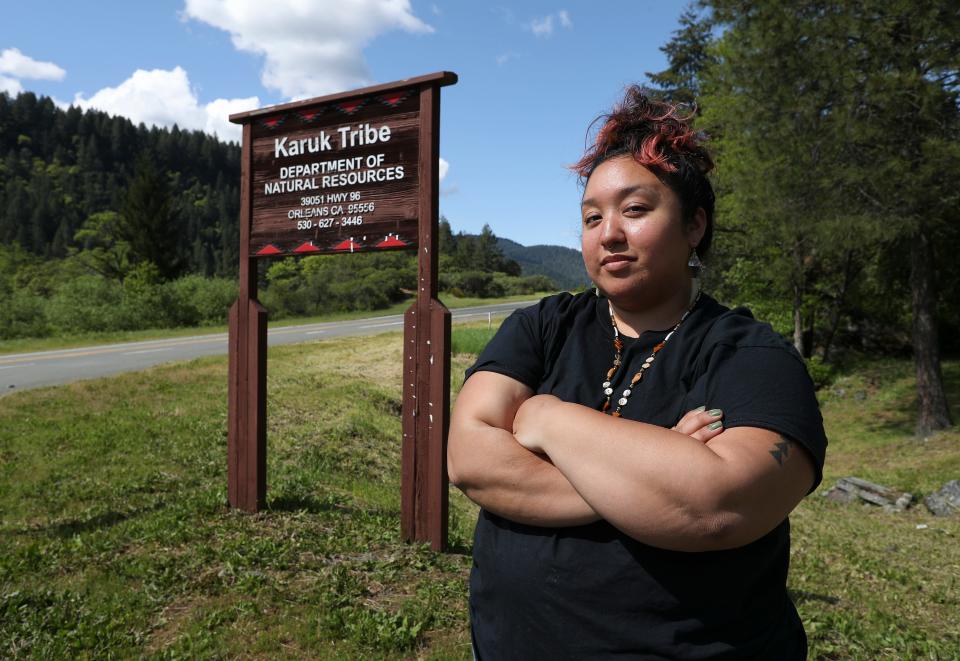
“The tribe does have a lot of knowledge,” she said. “A lot of these places are in our backyards, and in our family and ceremonial areas.”
Salmon is a staple for the Karuk Tribe, Preston said, over the sounds of the rushing Klamath River nearby. Animals are also used in ceremonial regalia, she added.
And national forests, a natural oasis set aside for the American public — “This is your forest,” reminds Gabriel — have become unsafe in many places.
More: Native tribal group reclaims California redwood forest: ‘It’s like a healing for our ancestors’
“There are entire areas — in the Mendocino National Forest, Six Rivers, Angeles — that are simply no-go areas because of the high level of cartel activity,” said Rich McIntyre, director of the CROP Project. “You’re hiking in the woods, and all of a sudden, you’re looking down the business end of an AK-47.”
For trail users, illegal grows are a “very real risk” in Northern California, said Matt Root, who leads a regional hiking group based in Redding. He has educated the group on common indicators of trespass grows, such as large trash heaps or irrigation lines deep in the forest.
Wildfires and water wars
Two California condor chicks sat in their nest at the Ventana Wildlife Society sanctuary in 2020.
They didn’t stand a chance.
That August, the Dolan Fire tore through California’s Big Sur region, engulfing more than 120,000 acres and virtually wiping out the sanctuary.
Camera footage at the sanctuary captured the moment the wildfire tore through the sanctuary, roasting the chicks alive.
The fire also killed nine other California condors, a species of which only a few hundred remain.
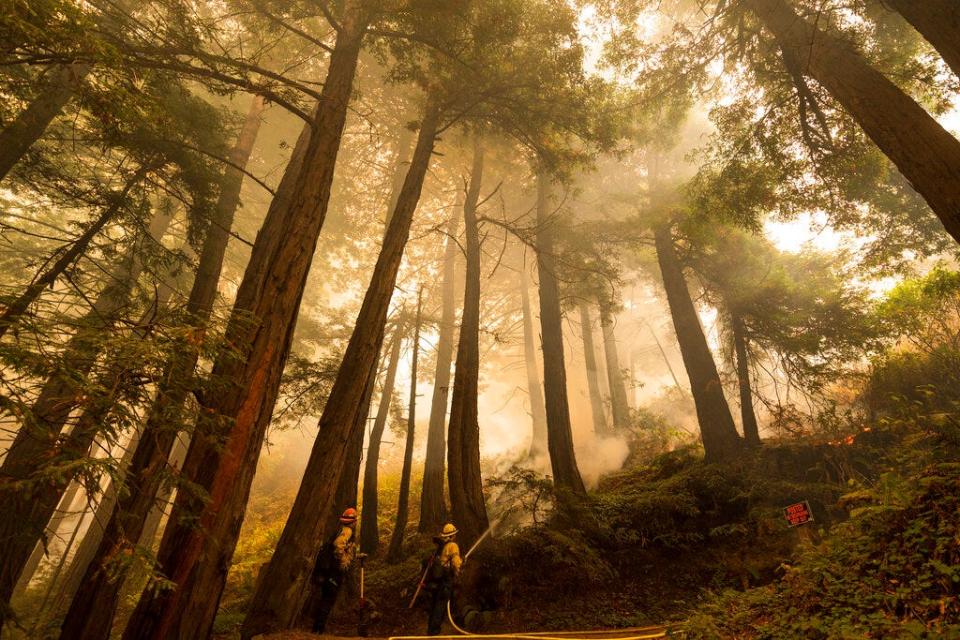
A law enforcement investigation later found the fire to be arson, originating from a trespass grow site operated by a drug trafficking organization.
Dolan was one of at least four California wildfires between 2008 and 2020 started by drug trafficking organizations growing cannabis on public lands. Collectively, they engulfed over 200,000 acres and cost authorities $260 million to suppress, according to Gabriel.
Significant swaths of the destroyed land was critical habitat for threatened and endangered species. Thousands of animals were killed.
More: 20 endangered condors die in Arizona amid flu outbreak; California agencies on high alert
And even as trespass grows spark these so-called “megafires” on the dry California landscape, they also continue to draw huge amounts of water from already parched rivers and streams.
At a trespass grow in Shasta-Trinity National Forest, irrigation lines snake through steep topography and thick brush, carrying water about a half-mile to a grow site.
Or at least they used to, before authorities raided the site in October, arrested one grower and disconnected the line from the nearby source.
These lines were diverting countless gallons of water from the headwaters of a nearby tributary to the South Fork of the Trinity River. In return, the tributary received toxic pesticides and fertilizer runoff.
Billions of gallons of water have gone to these operations over the years. Across thousands of sites, the draw from the state’s parched water supply is massive.
And this state can’t afford to lose a single drop.
“California has a long history of fighting for water,” said Yvonne West, director of the California Water Board office of enforcement.
The North Coast region, which has endured a large concentration of trespass grow operations, has experienced a more dramatic decline in rainfall than anywhere else in the U.S.
Annual rainfall data analyzed by Climate Central shows the North Coast region now receives about 7 inches less average rainfall than it did in 1970.
The state’s weather earlier this year, including “a parade” of atmospheric river storms, a revival of the long-lost Tulare Lake and more than 50 feet of snow in some areas, has provided relief for western water shortages, but not a solution.
Because of water shortages in the past, the state’s Water Board has had to place curtailments on watersheds across the state — orders that limit who gets to use water, and how much, during dry periods.
California’s Russian, Shasta and Scott watersheds have been hit hard by curtailments in recent years. All three are near areas with high densities of illegal cultivation sites.
While the region’s legal water users suffer through shortages, drug trafficking organizations forge ahead unhindered.
‘It’s everywhere’
Along a web of dirt roads in the Trinity County forest, trash is piled higher than the law enforcement officers walking past it.
Several crushed vehicles sit in the piles, some graffitied or riddled with bullet holes. Empty butane canisters, heaped together in dozens, sit scorched in burn pits that appear to have spread to a few nearby charred redwood trees.
Trinity County sheriff's deputies and environmental health department staff walk amid the rubble, much of it strewn across the forest floor by bears or other wildlife.
Whoever left this mess behind also abandoned garbage bags full of rotting marijuana.

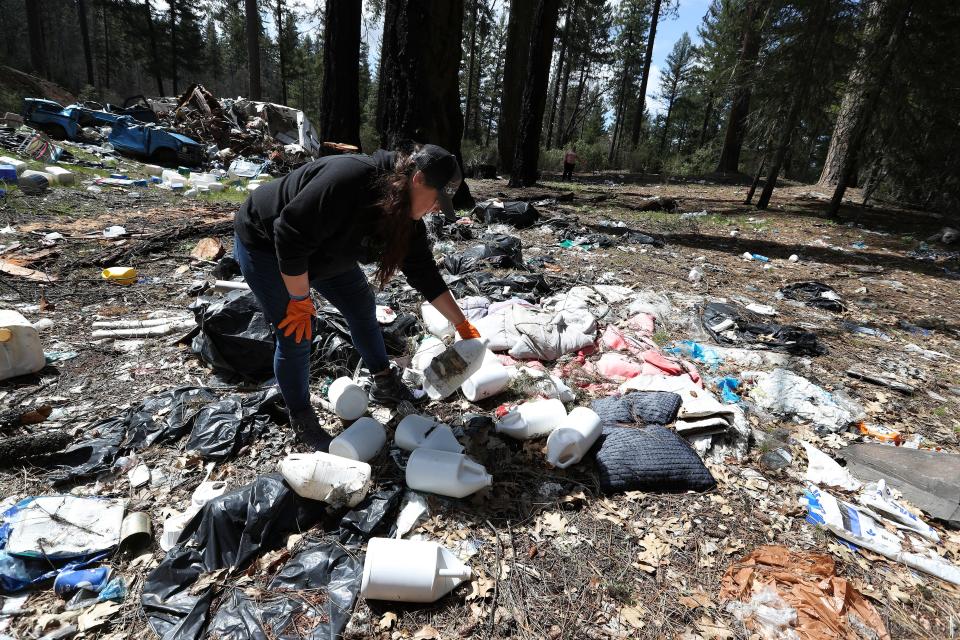
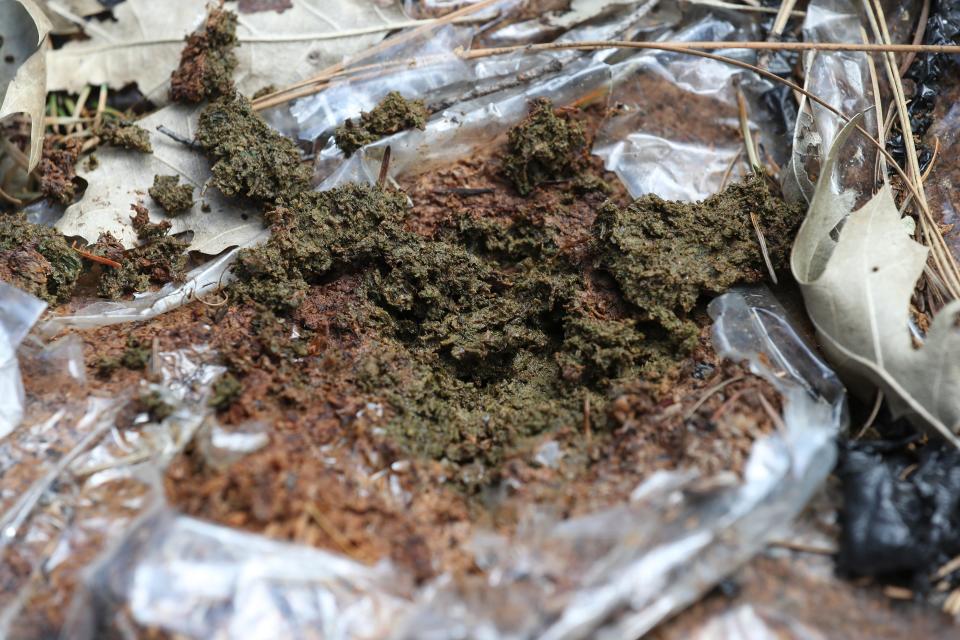
In this community, there are more than a thousand small private parcels being used for marijuana cultivation. Most of them are operating illegally, according to local officials.
“It’s everywhere,” said Ron Whitman, a sheriff’s deputy for Trinity County. “You can’t throw a rock in Trinity County without hitting a marijuana grow.”
Not all of them are causing this environmental damage, but some are.
Many of the trees here are black and barren from past wildfires, though the fire blew through this land before the cannabis growers that are here now. Some of what was spared from the fire was clear-cut to make room for unpermitted grows and associated infrastructure.
“It was pristine out here,” recalls Ron Hanover, a reserve deputy who originally joined the force in 1998. Now, it seems largely devoid of wildlife, he said, as healthy habitat has dwindled.
The effects of irresponsible cultivation on private land still impact natural resources. Wildlife rely on habitat on private land, and runoff from those properties can enter waterways and move downstream.
Standing beside the flowing Post Creek, Kristy Anderson, environmental health director for Trinity County, examines a slew of trash spread from the side of the road down into the water. A frog sits still atop the heap, camouflaged.
Anderson can’t say for sure whether chemicals they detected uphill from here have contaminated this waterway. Her department doesn’t have the funding to conduct testing.
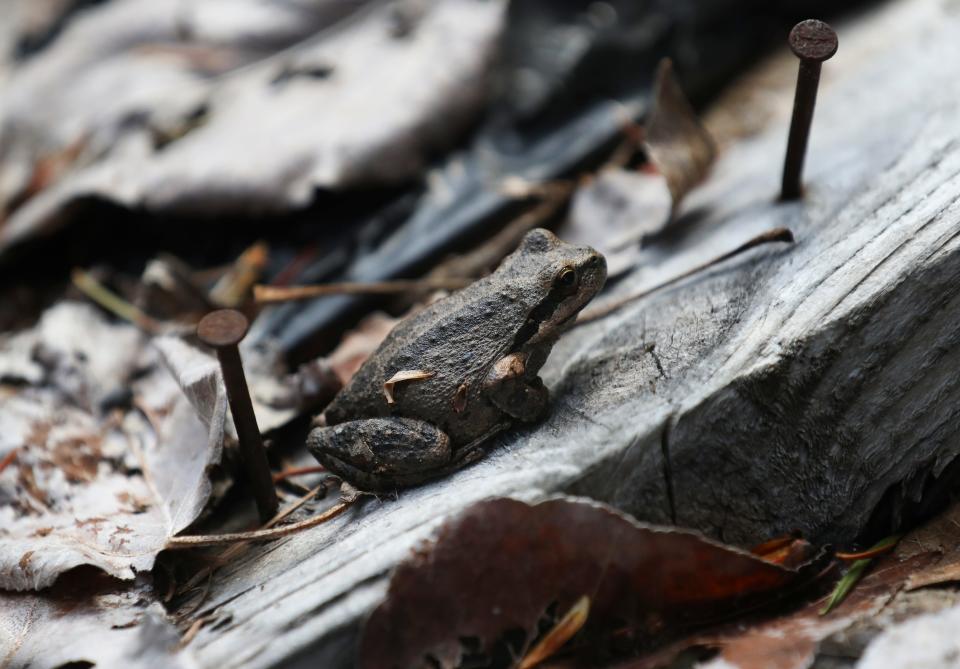
"The pesticide use and the downstream contamination from the private land grows isn't really being looked at at all," said Wengert, with IERC. "How is that massive input of pesticides affecting the entire landscape, from not just trespass grows, but private grows too? That concerns me."
Some drug trafficking operations have moved from California’s public forestlands, where scrutiny from the Forest Service and others has been significant, to private parcels, where authorities lack the same jurisdiction to investigate.
When they do, it can turn violent. Whitman recalled a gunfight erupting with a grower who he said was later identified as a part of the notorious Mara Salvatrucha gang, or MS-13.
“In order for us to go and take down an illegal grow on private property, we need a search warrant,” said Janice Mackey, a spokesperson for the California Department of Fish and Wildlife, the agency responsible for cannabis cultivation enforcement. “There are a lot more steps.”
How to quash a cartel
Trespass growers are nothing if not persistent.
After more than a decade spent studying these operations, Gabriel said he’s consistently impressed with the ingenuity and grit displayed by the workers running them.
Looking out toward the Trinity Alps, he pointed to a clearing where a grow site had been established on a mountainside. To hike up to that site from the nearest road, he’d need six or seven hours.
Trespass growers are doing it in half the time, Gabriel said, often while carrying propane tanks or 50-pound bags of fertilizer the whole way.
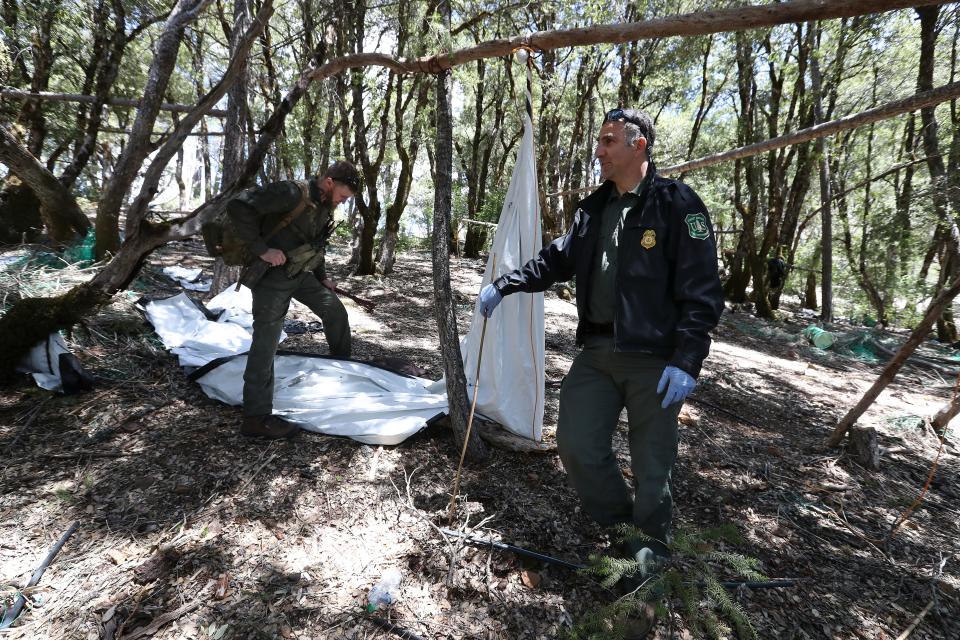
They also bring personal items, possibly linking them to particular cartels. Gabriel said enforcement officers sometimes find candles or offerings to Jesús Malverde, for example — a so-called "narco-saint" particularly popular among drug traffickers and in the Sinaloa state of Mexico, where the infamous Sinaloa Cartel is based.
Workers often labored previously in almond orchards or the fields of California's central valley before being recruited to trespass grows in the north, Gabriel has found. They’re able to assemble elaborate irrigation systems and grow in harsh soil conditions.
And as authorities ramped up aerial surveillance, trespass growers adapted their grow sites, spreading them out and making them harder to spot from above.
"They're getting sneakier and sneakier," said Higley, the Hoopa Valley Tribal Forestry biologist.
As such, addressing trespass grows takes resources that haven't always been readily available.
In Humboldt County, Sheriff William Honsal said his department was able to “basically quash” trespass growing in recent years.
Drug trafficking organizations “are not an issue in Humboldt,” said Natalynne DeLapp, executive director of the Humboldt County Growers Association, in an email. “It is not 2010 anymore.”
More: Marijuana wars: Violent Mexican drug cartels turn Northern California into ‘The Wild West’
Some other counties have had more difficulty reining them in.
But Honsal said he’s noticed a decline in funding support for confronting drug trafficking organizations across the region. Despite past success in enforcement, he fears a gap in funding could lead to a resurgence.
“We still need to pour resources into it,” the sheriff said. “We can’t back off.”
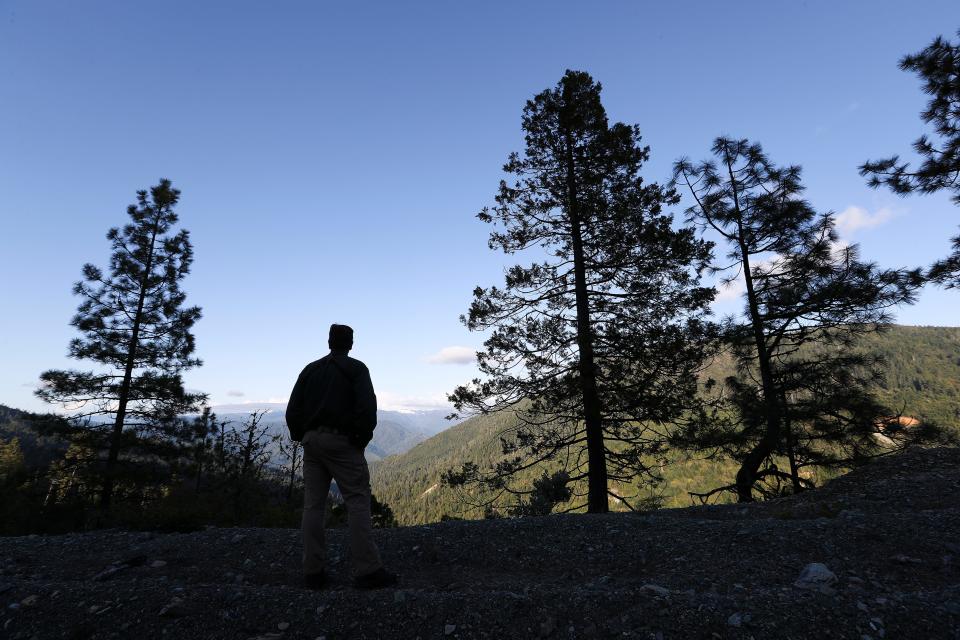
In the neighboring congressional district, Republican U.S. Rep. Doug LaMalfa is co-sponsoring a bipartisan bill that would supply the Forest Service with $250 million over 10 years to tackle the scourge of trespass grows nationally, from identifying sites to remediating them.
Historically, when authorities clear a trespass grow and remove the infrastructure, drug trafficking organizations very rarely return, Gabriel said. The bill would also represent a notable appropriation, since past enforcement efforts have largely come from the Forest Service's general budget.
U.S. Rep. Jared Huffman, representing Humboldt and the rest of the North Coast, sits on the House Committee on Natural Resources and previously worked as an attorney for the Natural Resources Defense Council.
The Democrat believes the quickest way to crack down on the viability of trespass grows is to legalize marijuana federally. Enforcement and raids alone, he said, “will never get you there.”
Without supporting the legal market and making it functional for responsible growers, Huffman said, "the cartels are going to continue to operate with impunity."
Last year, dozens of environmental organizations signed a letter calling on Congress to maintain steady funding "to address this vexing public health, public safety, and natural resources issue" of trespass grows.
"Just from the degradation of the habitat and potentially impacting meat sources or watersheds or things that take a long time to recover ... it's like someone doing it in your backyard," said Devin O'Dea, California chapter coordinator for Backcountry Hunters & Anglers, one of the undersigned organizations.
"This is your land."
This article originally appeared on Louisville Courier Journal: California pot trade linked to cartels leaves chemicals, dead animals

